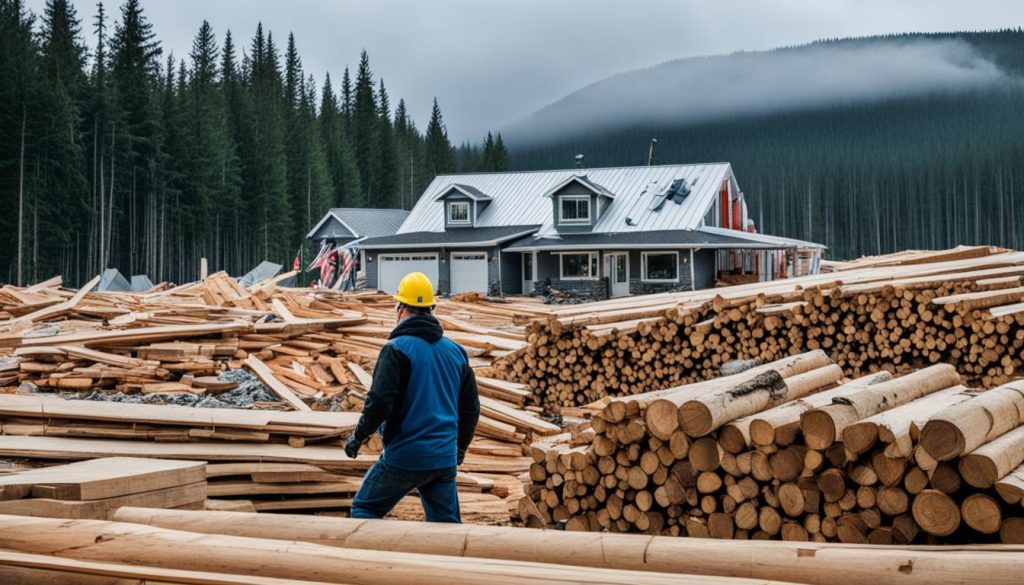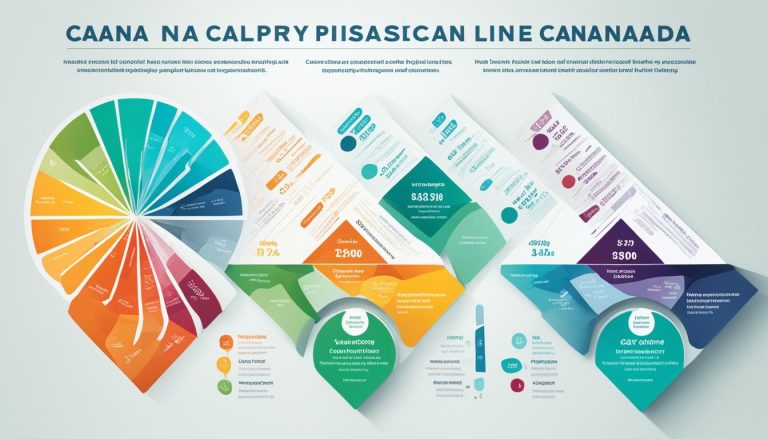Canada is renowned for its vast forests and abundant natural resources, making it one of the world’s leading producers and exporters of lumber. However, in recent years, Canadians have been grappling with skyrocketing lumber prices, leaving many puzzled and frustrated. The question on everyone’s mind is: why is lumber so expensive in Canada? This article aims to delve into the factors behind this soaring cost, explore the current situation, and shed light on the main culprits contributing to this unprecedented surge. So, why is lumber so expensive in Canada right now? And which country stands out as the largest importer of Canadian lumber? Let’s uncover the answers and venture into the complex world of the lumber industry.
Current Trends in Canadian Lumber Prices
The Canadian lumber market has experienced a tumultuous journey over the past couple of years. During the height of the COVID-19 pandemic, lumber prices in Canada skyrocketed as reduced production and heightened demand from DIYers and home builders created a supply-demand imbalance. A basic 2×4 stud, for instance, reached as high as $12 before settling back to around $4 on average.
1. Pandemic-Driven Price Surge
The pandemic-driven price surge was a result of several factors. Sawmills and other lumber production facilities were forced to reduce operations due to safety protocols and labor shortages, leading to a significant drop in lumber supply in Canada. At the same time, the surge in home improvement projects and new construction activities, driven by people spending more time at home, resulted in a spike in lumber demand. This combination of reduced supply and increased demand led to the unprecedented rise in Canadian lumber costs.
2. Recent Gradual Decline
In recent times, however, lumber prices have started to gradually decline. Experts attribute this trend to a combination of factors, including higher interest rates and a slowing housing market. As the cost of borrowing increases, potential homebuyers may be deterred, leading to a decrease in demand for new construction and, consequently, lumber demand in Canada.
3. Factors Contributing to Price Fluctuations
The key factors contributing to the ongoing lumber price fluctuations in Canada include the housing market conditions, interest rates, and various supply and production issues. While a gradual decline in prices is expected, industry experts suggest that lumber prices in Canada are unlikely to return to pre-pandemic levels anytime soon, as the market continues to grapple with the aftereffects of the pandemic and other emerging challenges.

Housing Market Conditions and Lumber Demand
The Canadian housing market plays a crucial role in determining the prices of lumber and wood products. As the construction industry continues to thrive, with more new projects being completed, the demand for lumber is likely to decrease. However, the impact on the real estate market remains uncertain, as factors such as inflated home prices and higher interest rates may pose challenges for first-time homebuyers, potentially affecting the overall demand for lumber.
1. Impact of New Construction Projects
As the Canadian economy recovers and the construction sector expands, the completion of new housing projects will result in an increased supply of lumber and wood products. This increased inventory is expected to lead to a decrease in lumber prices, as the demand from builders and contractors is likely to subside. The industry experts are closely monitoring the progress of these new construction initiatives and their impact on the lumber industry canada and wood prices canada.
2. Real Estate Market Uncertainties
Despite the potential for increased lumber supply, the uncertainties surrounding the Canadian real estate market may continue to influence the demand for lumber and wood products. The combination of inflated prices of existing homes and higher interest rates could deter first-time homebuyers, potentially impacting the overall demand for construction material costs canada and the need for lumber in new residential projects.

Interest Rates and Their Effect on Lumber Prices
The Canadian housing market plays a crucial role in determining the demand for lumber and wood products. As interest rates rise, potential homebuyers may be discouraged from entering the market, subsequently impacting the demand for lumber. The combination of inflated prices of existing homes and higher interest rates can pose significant challenges for first-time homebuyers, further dampening the overall demand for lumber and wood products.
1. Higher Interest Rates and Homebuyer Deterrence
According to industry experts, higher interest rates in Canada can dissuade potential homebuyers from making purchases, as the cost of borrowing becomes more expensive. This decrease in housing demand can have a direct effect on the demand for lumber and wood used in construction projects, potentially leading to a decline in lumber prices.
2. Challenges for First-Time Homebuyers
The article notes that the combination of inflated home prices and rising interest rates may pose significant challenges for first-time homebuyers in the Canadian market. As mortgage payments become less affordable, these prospective buyers may be forced to delay or forgo their home purchases, further impacting the demand for lumber and wood products used in new home construction.

Supply and Production Factors
The availability of lumber and wood products is a crucial factor influencing their prices in Canada. Disruptions in the supply chain, labor shortages, and government policies can all impact the supply and subsequently drive up lumber prices.
1. Transportation Disruptions
The transportation of raw materials and finished products is a vital component of the lumber industry in Canada. Severe weather events, such as the devastating floods in British Columbia in 2021, can create supply shocks and transportation challenges, leading to increased competition for limited transportation options and further lumber supply shortage and price volatility.
2. Labor Shortages
The lumber industry in Canada has faced persistent labor shortages, exacerbated by the COVID-19 pandemic. The lack of skilled workers in the forestry, manufacturing, and transportation sectors has disrupted the supply chain, contributing to the lumber supply shortage and driving up prices.
3. Government Policies
Government policies and regulations can also have a significant impact on the lumber industry and the pricing of lumber products in Canada. For instance, lumber tariffs imposed by the Canadian government or trade disputes with other countries can influence the cost and availability of lumber, affecting the overall market dynamics.

Impact of Wildfires on Lumber Supply
The lumber industry in Canada has endured a series of challenges, and the recent wildfires in Alberta and Quebec have further exacerbated the situation. These historic fires have dealt a significant blow to softwood lumber production, leading to mill evacuations and temporary closures that have constrained the lumber supply in Canada.
1. Alberta and Quebec Wildfires
The devastating wildfires that swept through Alberta and Quebec have disrupted the lumber industry in Canada, forcing the evacuation of mills and temporarily halting operations. This has had a ripple effect on the supply of softwood lumber, a critical component in construction projects across the country.
2. Temporary Mill Closures and Evacuations
As the wildfires raged, lumber mills in the affected regions were forced to shut down and evacuate their workers, leading to a significant reduction in production capacity. This interruption in the supply chain has resulted in a tightening of wood prices in Canada, as buyers scramble to secure limited stocks.
3. Effects on US Softwood Lumber Imports
Canada supplies around 80% of the softwood lumber imported by the United States, making it a critical supplier for the American market. With the disruptions caused by the wildfires, the availability and affordability of softwood lumber in the US are also likely to be affected, as the supply from Canada dwindles.
Baltic Birch Plywood Supply Challenges
The supply of Baltic birch plywood in Canada has faced significant uncertainty due to a confluence of geopolitical issues and complex supply chain dynamics. The ongoing conflict between Russia and Ukraine, as well as the trade tensions between the United States and other nations, have had a notable impact on the availability of this specialized wood product.
1. Geopolitical Issues
The Baltic region, which includes countries like Russia and Ukraine, has traditionally been a major exporter of birch plywood. However, the current geopolitical tensions have disrupted the supply chain, leading to concerns about the consistent availability of this material in the Canadian lumber prices and Canadian lumber costs markets.
2. Complex Supply Chains
Many suppliers of Baltic birch plywood are based in Europe, adding an additional layer of complexity to the supply chain. The construction material costs in Canada are further impacted by the intricate logistics and transportation challenges involved in sourcing this product from overseas.
3. Trade Tensions and Tariffs
The trade restrictions and tariffs imposed by the United States government have also contributed to the supply challenges faced by Canadian importers of Baltic birch plywood. These trade barriers have made it more difficult and costly to acquire this material, adding to the construction material costs faced by Canadian businesses and consumers.
Why is Lumber So Expensive in Canada?
The high costs of lumber and wood products in Canada can be attributed to a combination of factors, including the pandemic-driven price surge and the subsequent gradual decline in recent times. Various influential elements, such as housing market conditions, interest rates, and supply and production issues, have all contributed to the fluctuations in lumber prices across the country.
1. Gradual Price Decline Expectations
While experts predict a gradual decline in lumber prices over the next six months, it’s unlikely that the costs will return to pre-pandemic levels anytime soon. The housing market, with its inflated prices and higher interest rates, is expected to continue impacting the demand for lumber and wood products, further influencing the pricing dynamics.
2. Potential for Price Stabilization
As the market adjusts to the changing conditions, there is a possibility of lumber prices stabilizing to some degree. However, the inherent volatility of the industry and the unpredictable nature of factors like wildfires, supply chain disruptions, and government policies suggest that the market may continue to experience fluctuations in the coming months.
3. Continued Market Volatility
The Canadian lumber industry has been characterized by significant price swings and market volatility, making it challenging for both consumers and industry players to anticipate and plan for future trends. The combination of supply, demand, and external factors, such as inflation and geopolitical tensions, is likely to keep the lumber market in a state of flux, testing the resilience and adaptability of stakeholders across the value chain.
Lumber Price Increases at Home Improvement Stores
The rising costs of lumber and wood products have not only impacted the construction industry but have also trickled down to the shelves of home improvement stores across Canada. A recent report highlights the significant price hikes for plywood and dimensional lumber that are now being felt by homeowners and DIY enthusiasts.
1. Plywood and Dimensional Lumber Price Hikes
According to the latest data, the price of a sheet of 3/4 plywood at home improvement stores in Canada has soared to an eye-watering $80, up from around $50 just a year ago. Similarly, a 2×6 piece of dimensional lumber now costs nearly $20, a substantial increase from the previous year’s price.
2. Impact on Home Improvement Projects
These price hikes for lumber prices canada, wood prices canada, and construction material costs canada have made it increasingly challenging for homeowners to complete their planned home improvement projects within their budgets. Many DIYers and homeowners are now faced with the difficult decision of scaling back their projects or finding alternative, more affordable materials to work with.
Market Volatility and Trader Challenges
The volatility of the Canadian lumber market has posed significant challenges for traders and industry participants. According to the third source, the lumber industry has experienced “violent swings” in prices, creating an unpredictable environment that can quickly make or break traders’ positions.
1. Violent Price Swings
The unprecedented fluctuations in lumber prices have created a challenging landscape for traders to navigate. The article explains that the market has undergone “violent swings” that can rapidly shift the fortunes of those participating in the industry. These sudden and drastic changes in lumber prices canada have made it difficult for traders to effectively manage their positions and mitigate the associated risks.
2. Difficulty in Predicting Market Trends
The unpredictability of the canadian lumber costs and the lumber industry canada has also made it challenging for traders to anticipate market trends and make informed trading decisions. The source emphasizes that the volatility of the lumber market makes it arduous for traders to accurately forecast price movements and position themselves accordingly. This level of uncertainty has added an extra layer of complexity to the already challenging task of navigating the lumber trade.
Inflation and Its Impact on Lumber Pricing
As the Canadian economy grapples with inflationary pressures, the impact on lumber prices and construction material costs has become a growing concern. While the Canadian lumber costs have not yet experienced a significant surge due to inflation, the industry is facing other challenges that may eventually lead to price increases.
1. Rising Energy Costs for Mills
One of the primary factors influencing the potential impact of inflation on lumber prices is the rising energy costs for mills. As the cost of fuel and electricity continues to rise, lumber producers are facing increased operational expenses, which could translate into higher lumber prices for consumers.
2. Oversupply and Muted Demand
However, the current lumber market in Canada is characterized by an oversupply, and demand has slowed significantly due to inflation and rising interest rates. This dynamic has helped to offset the inflationary pressures, as mills are hesitant to pass on the increased costs to consumers in the face of weakening demand.
The third source suggests that if the current trends of oversupply and muted demand continue, inflationary pressures will eventually start to affect lumber pricing once the market stabilizes. This means that while construction material costs in Canada may not be significantly impacted by inflation at the moment, the potential for price increases remains a concern for the industry and homeowners alike.
Conclusion
The article has delved into the multifaceted reasons behind the soaring prices of lumber in Canada. From the pandemic-induced price surge to the gradual decline in recent times, the factors shaping the lumber market are complex and ever-evolving. The impact of housing market conditions, interest rates, supply and production issues, wildfires, and the challenges with Baltic birch plywood supply have all contributed to the volatility in lumber prices canada and canadian lumber costs.
While experts predict a gradual decline and potential stabilization of lumber prices in the coming months, the market is expected to continue experiencing unpredictability due to various unpredictable factors. The article has also highlighted the significant price increases for plywood and dimensional lumber at home improvement stores, posing challenges for homeowners looking to undertake construction material costs canada projects. Additionally, the challenges faced by traders in navigating the unpredictable lumber industry canada have been explored.
Overall, this article provides a comprehensive understanding of the complex landscape of the lumber supply shortage canada, lumber tariffs canada, and lumber demand canada in Canada, equipping readers with insights into the expected market trends and the factors driving the high wood prices canada in the near future.
FAQ
1. Why is lumber so expensive in Canada right now?
Lumber prices in Canada have surged during the COVID-19 pandemic, with factors such as reduced production, increased demand, supply chain disruptions, and other market conditions contributing to the high prices.
2. Where does Canada get most of its lumber from?
Canada supplies around 80% of US softwood lumber imports, making it a major supplier of lumber.
3. How much does wood cost in Canada?
Wood and lumber prices in Canada have seen significant increases, with a basic 2×4 stud reaching as high as $12 before settling back to around $4 on average. Plywood and dimensional lumber prices at home improvement stores have also surged.
4. Does the US import lumber from Canada?
Yes, the US imports a significant amount of lumber from Canada, as Canada supplies around 80% of US softwood lumber imports.
5. Which country is the largest importer of lumber?
Canada is a major exporter of lumber, but the largest importer of lumber is not specified in the provided information.
6. Does Canada export a lot of wood?
Yes, Canada is a significant exporter of lumber, supplying around 80% of US softwood lumber imports.
7. What factors have contributed to the high lumber prices in Canada?
Factors contributing to the high lumber prices in Canada include the pandemic-driven price surge, gradual decline in recent times, impact of housing market conditions, interest rates, supply and production issues, wildfires, and challenges with Baltic birch plywood supply.
8. How have interest rates affected lumber prices in Canada?
Higher interest rates can discourage potential homebuyers, affecting the demand for lumber and wood products, and posing challenges for first-time homebuyers.
9. How have supply and production factors influenced lumber prices in Canada?
Supply chain disruptions, labor shortages, and government policies have impacted the supply of lumber and wood products, contributing to the price fluctuations.
10. What is the impact of wildfires on lumber supply in Canada?
Historic wildfires in Alberta and Quebec have dealt a blow to softwood lumber production, forcing evacuations and temporary closures of mills, which is likely to affect lumber availability and affordability in Canada and the US.




